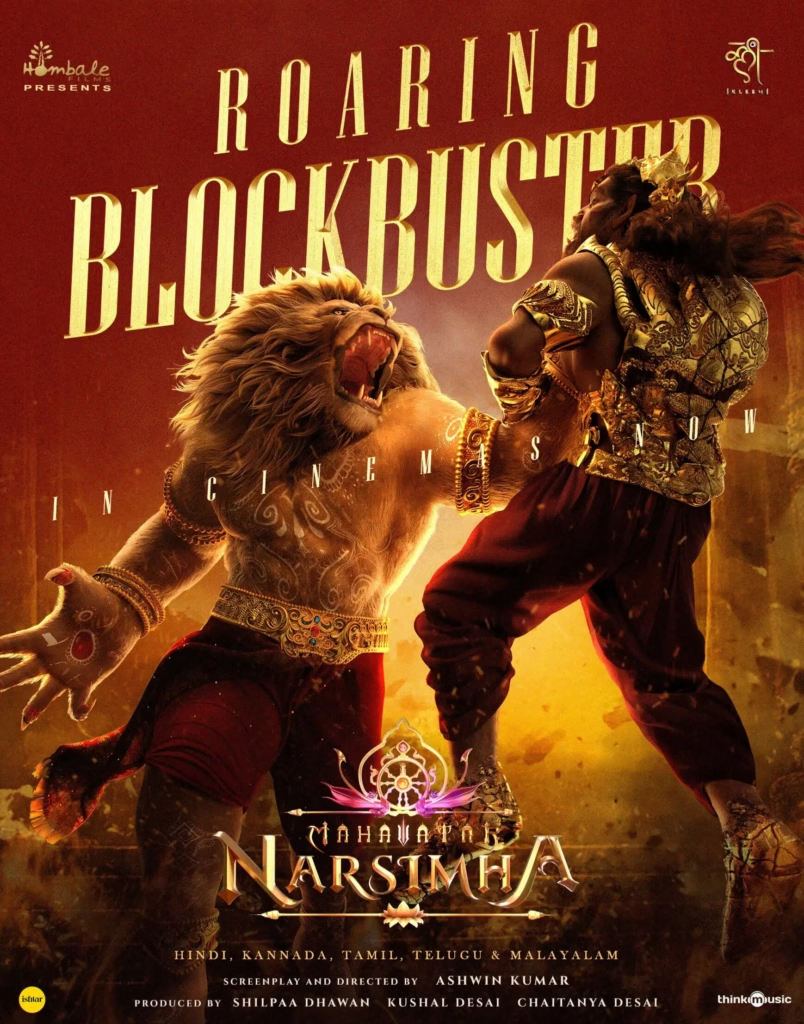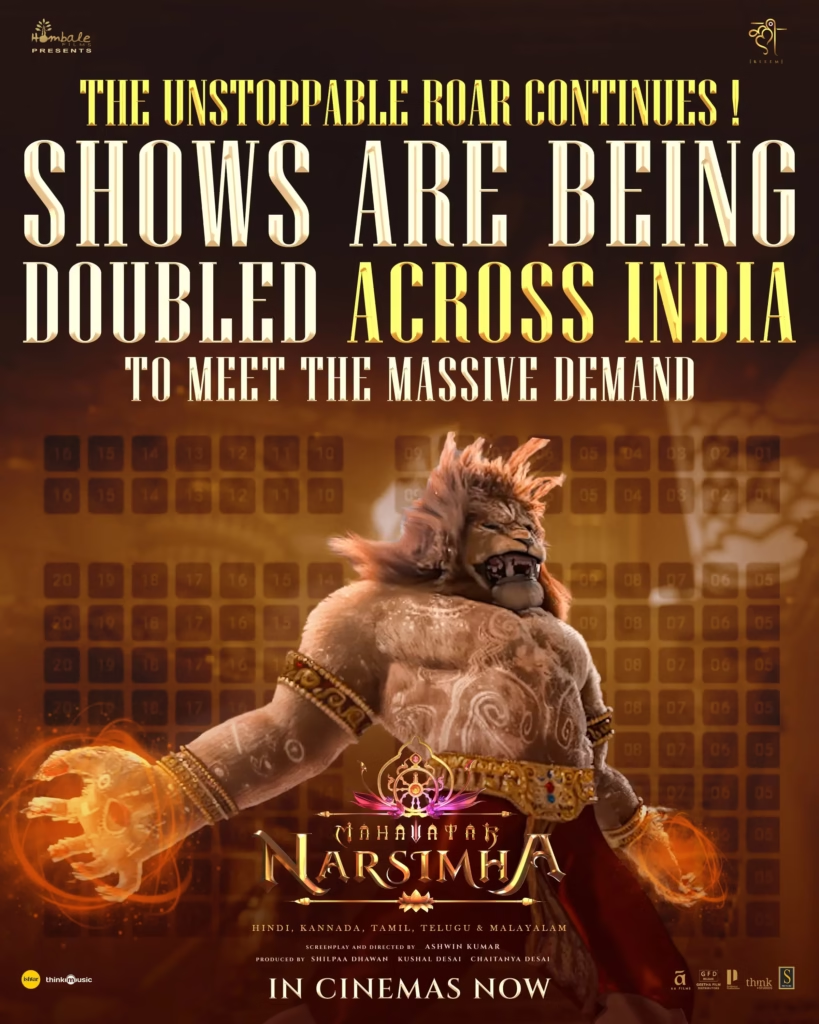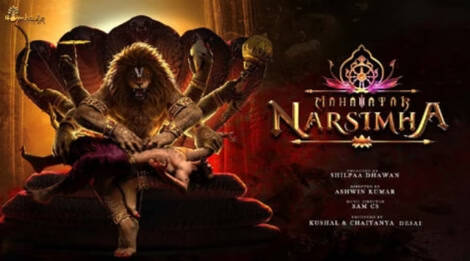The much-talked-about Hindi animated film Mahavatar Narsimha has captured national attention with its mythological theme, spiritual storyline, and visually captivating animation. But is it really the highest-grossing Hindi animated film ever, as many media outlets have claimed?

Mahavatar Narsimha is directed by Ashwin Kumar | Image: X
Mahavatar Narsimha: A Mythological Epic Reimagined in Animation
The July 25, 2025 release of Mahavatar Narsimha marks a rare and ambitious attempt in Indian cinema to present a divine narrative through the lens of animation. Rooted in ancient scriptures and powered by contemporary visuals, this film revisits one of the most powerful avatars of Lord Vishnu—Narsimha, the half-man, half-lion incarnation who emerged to protect dharma and annihilate a dharma.
From emotional depth to explosive action, the movie attempts to blend faith with fantasy in a form that speaks to both modern viewers and traditional devotees.
Mahavatar Narsimha Cast, Crew & Production Details
Direction and Writing
- Director: Ashwin Kumar (debut)
- Writer: Jayapurna Das
- Screenplay & Dialogue: Rudra P. Ghosh
- Hombale Films, in collaboration with Kleem Productions,
Technical Team
- Music Composer: Sam C. S.
- Editing: Ajay Verma & Ashwin Kumar
- Production Houses: Kleem Entertainment & Hombale Films
- Presenter: Vijay Kiragandur (of KGF fame)
Languages and Runtime
- Languages: Hindi (original), with dubs in Tamil, Telugu, Kannada, and Malayalam
- Runtime: 141 minutes
- Formats: Released in both 2D and 3D
Storyline of Mahavatar Narsimha
A Tale of Desire, Devotion, and Divine Justice
A profoundly symbolic story that spans generations and divine realms is at the core of Mahavatar Narsimha.
Despite Kashyapa’s warnings, Diti, one of his wives, gives in to passion at an unfavorable time. Two asura (demonic) brothers destined for evil, Hiranyaksha and Hiranyakashipu, are born as a result of this deed.
They come out as mighty forces, trained by Shukracharya, with an objective of disrupting the cosmic order and confronting Lord Vishnu. A fierce anger consumes Hiranyakashipu after Varaha, Vishnu’s boar-avatar, defeats Hiranyaksha.
In order to acquire more power and vengeance, Hiranyakashipu goes through extreme repentance to make Lord Bharma pleased and gets a boon from Brahma that makes him almost unbeatable: he cannot be killed by a weapon, a man, a beast, a day, or a night.
Interestingly, his own son Prahlada, who grows up in an environment full of ego and disobedience, turns out to be an ardent devotee of Vishnu. The bond between the father and son become a spiritual battleground, as Prahlada don’t want to give up his faith in Lord Vishnu.
The appearance of Narasimha, a creature that defies classification—not man nor beast; day or night; indoors or out—marks the story’s climax. Justice is administered in a terrifying and transcendental manner as divine flaws are revealed.
Plus Points of Mahavatar Narsimha
Bold Vision and Creative Leap
One of the standout aspects of Mahavatar Narsimha is its daring decision to render a deeply revered tale in animated form. While Indian animation has largely been limited to children’s content, this film ventures into unexplored territory—mythology told with cinematic gravitas.
It differs from conventional mythological retellings just because of this. The filmmakers uses a medium that is frequently disregarded by mainstream Indian cinema to elevate a devotional story.
Power-Packed Opening and the Varaha Avatar Sequence
The film’s opening forty minutes are lively and captivating. The animation quickly transports viewers to a world of gods, sages, and demons, and the pacing is precise.
An intense, expansive battle that honors ancient lore and provides the action Indian viewers are accustomed to, the Varaha avatar episode is a visual high point. This section’s scale, details, and choreography are remarkable and serve to ground the mythic tone of the movie.
Emotionally Grounded Devotion: Prahlada and Vishnu
The scenes that show Prahlada’s unshakable devotion are touching and spiritually shaking. These scenes brings back the film to its emotional center by contrasting Hiranyakashipu’s arrogance with its purity and a faith-based conviction.
The spiritual aspect of the film become strengthened through the vibrancy of scenes like Vishnu’s interventions and glances of Brahmaloka, Vaikuntha, and other heavenly realms from the universe.
Regardless of the absence of realistic imagery, the animation expertly integrates religious symbolism with celestial artistry to create a convincing mythic universe.
The Arrival of Mahavatar Narasimha: A Cinematic Shift

Mahavatar Narsimha is directed by Ashwin Kumar | Image: X
The movie changes from myth to legend as it approaches its climax. The movie completely changes course when Narasimha arrives.
Unlike the other characters, this avatar is depicted with ferocious elegance and intensity. The movie’s high point is the final battle with Hiranyakashipu, and his entrance, appearance, and manner are all impressive.
There is a tangible sense of divine wrath, thunderous sound design, and raw energy in the staging of the climactic confrontation. Particularly for viewers in smaller towns and religious communities that consider the Narsimha story to be sacred, these moments are both emotionally and visually powerful.
Mahavatar Narsimha Box Office Report
Opening Day Collections
According to official Wikipedia data and verified trade reports:
- Opening Day (July 25): ₹2.29 crore worldwide
- Hindi version: ₹1.51 crore
- Other languages: ₹0.78 crore combined
Total Gross So Far
- Estimated Domestic Gross (India): ₹3.9 crore
- Worldwide Gross (Including Overseas): ₹4.70 crore (citation needed)
These figures do not support claims that Mahavatar Narsimha is the highest-grossing animated Hindi film of all time. Previous animated hits like Hanuman (2005) and Chhota Bheem: Kung Fu Dhamaka had stronger commercial runs.
Audience Reception and Reviews
Critical Reviews
- India Today: 3.5/5 stars – Praised the emotional climax and portrayal of Narsimha
- The Indian Express: 2.5/5 stars – Noted visual appeal but criticized dialogue and execution
- Times of India: Described it as a “grand visual odyssey with emotional gaps”



